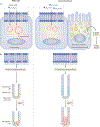Liver X receptors in lipid signalling and membrane homeostasis
- PMID: 29904174
- PMCID: PMC6433546
- DOI: 10.1038/s41574-018-0037-x
Liver X receptors in lipid signalling and membrane homeostasis
Abstract
Liver X receptors α and β (LXRα and LXRβ) are nuclear receptors with pivotal roles in the transcriptional control of lipid metabolism. Transcriptional activity of LXRs is induced in response to elevated cellular levels of cholesterol. LXRs bind to and regulate the expression of genes that encode proteins involved in cholesterol absorption, transport, efflux, excretion and conversion to bile acids. The coordinated, tissue-specific actions of the LXR pathway maintain systemic cholesterol homeostasis and regulate immune and inflammatory responses. LXRs also regulate fatty acid metabolism by controlling the lipogenic transcription factor sterol regulatory element-binding protein 1c and regulate genes that encode proteins involved in fatty acid elongation and desaturation. LXRs exert important effects on the metabolism of phospholipids, which, along with cholesterol, are major constituents of cellular membranes. LXR activation preferentially drives the incorporation of polyunsaturated fatty acids into phospholipids by inducing transcription of the remodelling enzyme lysophosphatidylcholine acyltransferase 3. The ability of the LXR pathway to couple cellular sterol levels with the saturation of fatty acids in membrane phospholipids has implications for several physiological processes, including lipoprotein production, dietary lipid absorption and intestinal stem cell proliferation. Understanding how LXRs regulate membrane composition and function might provide new therapeutic insight into diseases associated with dysregulated lipid metabolism, including atherosclerosis, diabetes mellitus and cancer.
Conflict of interest statement
Competing interests
The authors declare no competing interests.
Figures




Similar articles
-
Transcriptional and posttranscriptional control of cholesterol homeostasis by liver X receptors.Cold Spring Harb Symp Quant Biol. 2011;76:129-37. doi: 10.1101/sqb.2011.76.010702. Epub 2011 Aug 22. Cold Spring Harb Symp Quant Biol. 2011. PMID: 21859674 Review.
-
Liver X receptors (LXRs). Part I: structure, function, regulation of activity, and role in lipid metabolism.Postepy Hig Med Dosw (Online). 2007 Dec 3;61:736-59. Postepy Hig Med Dosw (Online). 2007. PMID: 18063918 Review.
-
Common and Differential Transcriptional Actions of Nuclear Receptors Liver X Receptors α and β in Macrophages.Mol Cell Biol. 2019 Feb 15;39(5):e00376-18. doi: 10.1128/MCB.00376-18. Print 2019 Mar 1. Mol Cell Biol. 2019. PMID: 30602495 Free PMC article.
-
Regulation of mouse sterol regulatory element-binding protein-1c gene (SREBP-1c) by oxysterol receptors, LXRalpha and LXRbeta.Genes Dev. 2000 Nov 15;14(22):2819-30. doi: 10.1101/gad.844900. Genes Dev. 2000. PMID: 11090130 Free PMC article.
-
Feedback modulation of cholesterol metabolism by the lipid-responsive non-coding RNA LeXis.Nature. 2016 Jun 2;534(7605):124-8. doi: 10.1038/nature17674. Epub 2016 May 11. Nature. 2016. PMID: 27251289 Free PMC article.
Cited by
-
Lipid Metabolism and Immune Checkpoints.Adv Exp Med Biol. 2021;1316:191-211. doi: 10.1007/978-981-33-6785-2_12. Adv Exp Med Biol. 2021. PMID: 33740251
-
Cholesterol Metabolic Reprogramming in Cancer and Its Pharmacological Modulation as Therapeutic Strategy.Front Oncol. 2021 May 24;11:682911. doi: 10.3389/fonc.2021.682911. eCollection 2021. Front Oncol. 2021. PMID: 34109128 Free PMC article. Review.
-
Cholesterol biosynthetic pathway induces cellular senescence through ERRα.NPJ Aging. 2024 Jan 12;10(1):5. doi: 10.1038/s41514-023-00128-y. NPJ Aging. 2024. PMID: 38216569 Free PMC article.
-
CYP7B1 deficiency impairs myeloid cell activation in autoimmune disease of the central nervous system.PNAS Nexus. 2024 Aug 21;3(9):pgae334. doi: 10.1093/pnasnexus/pgae334. eCollection 2024 Sep. PNAS Nexus. 2024. PMID: 39262855 Free PMC article.
-
Crosstalk Between LXR and Caveolin-1 Signaling Supports Cholesterol Efflux and Anti-Inflammatory Pathways in Macrophages.Front Endocrinol (Lausanne). 2021 May 27;12:635923. doi: 10.3389/fendo.2021.635923. eCollection 2021. Front Endocrinol (Lausanne). 2021. PMID: 34122329 Free PMC article.
References
Publication types
MeSH terms
Substances
Grants and funding
LinkOut - more resources
Full Text Sources
Other Literature Sources

